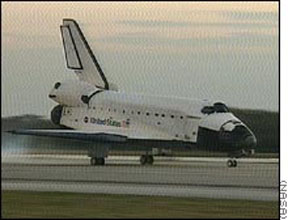Space Shuttle Endeavour touched down at Kennedy Space Center last
Click on image for full size
Courtesy of NASA
Endeavour Mission is Complete
News story originally written on March 01, 2000
After 11 long and stressful days in space, the Space Shuttle Endeavour and its crew landed safely at Kennedy Space Center last week. The astronauts completed the mission, which involved a detailed mapping of almost the entire planet. Astronauts gave the mission an "A+" because they mapped 80% of Earth's surface.
The mission was anything but boring. Troubles with latches and a faulty thruster threatened to end the mission prematurely. Fortunately, NASA scientists found ways to save on fuel, allowing the shuttle to complete the mission. The difficulties didn't end there, as heavy winds almost forced Endeavour to land at another sight in California.
Special radar equipment was used to map the Earth's surface. This is the first time maps will be created with all of the data coming from one source. The radar was used because it can penetrate through cloud cover. Scientists say it will take one to two years before the data will be completely turned into an actual map.
You might also be interested in:

It was another exciting and frustrating year for the space science program. It seemed that every step forward led to one backwards. Either way, NASA led the way to a great century of discovery. Unfortunately,
...more
The Space Shuttle Discovery lifted off from Kennedy Space Center at 2:19 p.m. EST, October 29th. The sky was clear and the weather was great as Discovery took 8 1/2 minutes to reach orbit for the Unitied
...more
A moon was discovered orbiting the asteroid, Eugenia. This is only the second time in history that a satellite has been seen circling an asteroid. A special mirror allowed scientists to find the moon
...more
Will Russia ever put the service module for the International Space Station in space? NASA officials are demanding an answer from the Russian government. The necessary service module is currently waiting
...more
During a period of about two days in early May, 1998, the ACE spacecraft was immersed in plasma associated with a coronal mass ejection (CME). The SWICS instrument on ACE, which determines unambiguously
...more
J.S. Maini of the Canadian Forest Service has referred to forests as the "heart and lungs of the world." Forests reduce soil erosion, maintain water quality, contribute to atmospheric humidity and cloud
...more
In late April through mid-May 2002, all five naked-eye planets are visible simultaneously in the night sky! This is includes Mercury which is generally very hard to see because of its proximity to the
...more















